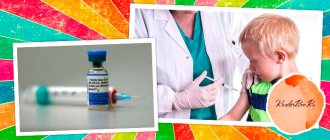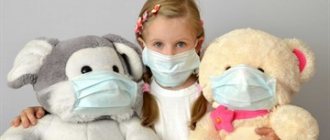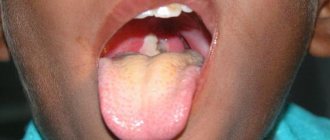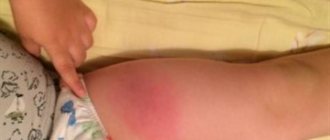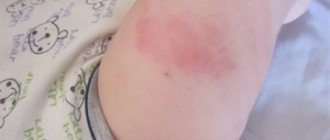Symptoms of measles in children (photos), treatment and prevention measures
Measles is one of the representatives of acute, highly contagious viral infections, characterized by inflammatory reactions in the mucous membranes of the oral cavity, conjunctiva and respiratory organs, accompanied by very high temperatures, intoxication symptoms, macular and papular rashes (see photo).
The causative agent of the disease is a filterable, negligible varion belonging to the Myxovirus family. It does not have high resistance in an open environment and dies quickly outside the body. A child can become infected with measles through contact with a carrier of the infection at the very peak of its infectiousness, several (3-4) days before the onset of the rash.
How does measles spread?
The virus spreads through the air, the current from which can even reach another floor through ventilation pipes. In a closed, cramped room, it easily affects the respiratory tract, mucous membrane of the throat and eyes. It also enters the body with droplets of saliva from a sick person when he sneezes or coughs. Sunlight quickly kills the measles virus. Disinfection of the room in which sick children were located is not required; good ventilation is sufficient, since the lifespan of the virus is only 2-3 hours at normal temperature.
If a child is not vaccinated on time, then in close contact with a sick person he will definitely get sick. The virus reaches its peak development towards the end of the incubation period and over the next few days. It is at this time that the patient is contagious to others and should not have contact with other children or attend kindergarten or school.
The measles virus, during its life processes, produces toxic substances that poison the body of children. A symptom of measles is a characteristic red rash on the face and body.
Causes of measles
Measles is one of the most contagious diseases. The infection is transmitted by airborne droplets.
A person who is not immune to measles will almost certainly become ill when exposed to the infection, regardless of their age. In order to get sick, it is not necessary to have direct contact with a carrier of the infection; you can become infected, for example, by entering the room where he was recently located. There are known cases of the measles virus spreading over significant distances with air flow. But at the same time, the virus is not stable in the external environment; it quickly dies outside the human body from exposure to various chemical and physical factors (irradiation, boiling, treatment with disinfectants).
The incubation period of measles ranges from 7 to 14 days. The source of infection is a patient with measles in any form. The patient is contagious to others, starting from the last days of the incubation period (last 2 days) until the 4th day of the rash. From the 5th day of the rash, the patient is considered non-infectious.
Illness in early childhood
Features of the course of measles in young children:
- Children under three months of age cannot become infected with measles - this is due to the fact that their mother passed on her immunity to them at birth. The woman herself was either vaccinated against measles or had it.
- Passive immunity, which lasts up to 6 months, protects infants at this age and they become infected extremely rarely.
- For early childhood, the atypical form of measles is more typical. There is a shortened catarrhal period, mild symptoms, the absence of Filatov-Koplik spots and enanthems on the oral mucosa. Sometimes the incubation period is replaced by a rash, and the catarrhal period is completely skipped.
- Although the symptoms in early childhood are not as severe, measles often causes complications. This is due to the fact that a weak immune system does not always know how to fight back a powerful virus that suppresses all the body’s defenses.

Measles symptoms, photo
Oddly enough, even the most perceptive parent will not see how measles begins (see photo). This insidious disease develops in stages, and the initial period can last weeks and not manifest itself at all. The child will continue to have fun and play, and at the same time the harmful virus will undermine his body from the inside.
1) Incubation period of childhood measles: 7–14 days (counted from the moment of infection until the immediate appearance of the first symptoms).
2. Catarrhal period, when children show the first signs of measles, reminiscent of all the symptoms of a cold:
- general malaise;
- lack of appetite;
- severe weakness;
- headache;
- insomnia;
- temperature 38–40°C;
- runny nose with purulent mucous discharge from the nose;
- swelling, redness of the eyelids;
- lacrimation;
- dry, persistent cough;
- conjunctivitis (purulent inflammation of the eye mucosa);
- loose stool;
- hoarse voice;
- photophobia;
- stomach ache;
- Children under one year of age often experience a decrease in body weight.
3. The main symptoms of measles in children (almost three weeks after the first signs of the disease):
- grayish-whitish small rashes (the size of a poppy seed) in the mouth, on the mucous membrane opposite the molars;
- after another 5 days, bright, merging spots appear (size - up to 10 mm), slightly rising above the skin: they begin to appear first behind the ears, on the forehead, then on the rest of the face, neck, then throughout the body, in lastly - on the arms and legs;
- small pink spots rapidly increase in size, merge, and take on an awkward, irregular shape;
- 3 days after intense rashes, the temperature rises again (in most cases) to 40.5°C.
The rash covers the child’s body for an average of 4 to 7 days; at first, it leaves brownish pigment spots that begin to peel off; after another couple of weeks, the skin completely clears. The rash disappears in exactly the same order as it appeared - from the face to the extremities. This is how measles manifests itself at different stages of its development: you need to know about this so as not to confuse the disease with other infectious diseases (with the same cold), not to self-medicate, and to show your child to the doctor in a timely manner.
Measles
Credits : World Health Organization
Newsletter N°286
February 2015
Key Facts
- Measles is a leading cause of death among young children, even with the availability of a safe and effective vaccine.
- Globally, there were 145,700 measles deaths in 2013—almost 400 per day or 16 per hour.
- Between 2000 and 2013, measles vaccination led to a 75% reduction in global measles deaths.
- In 2013, about 84% of all children worldwide received one dose of measles vaccine during their first year of life as part of routine health care, up from 73% in 2000.
- In 2000-2013 Measles vaccination has prevented an estimated 15.6 million deaths, making measles vaccine one of the most beneficial public health advances.
Measles is a highly contagious, severe disease of viral origin. In 1980, before widespread vaccination, there were an estimated 2.6 million deaths from measles.
Measles remains a leading cause of death among young children worldwide, even with the availability of a safe and effective vaccine. An estimated 145,700 people died from measles in 2013, most of them children under 5 years of age.
The causative agent of measles is a virus from the paramyxovirus family. The measles virus is usually transmitted through direct contact and also through the air, infecting the mucous membranes and then spreading throughout the body. Measles is a human disease and has not been reported in animals.
Accelerated immunization efforts have had a significant impact on reducing measles deaths. In 2000-2013 Measles vaccination prevented an estimated 15.6 million deaths. Global measles deaths fell by 75%, from 544,200 deaths in 2000 to 145,700 deaths in 2013.
Signs and symptoms
The first sign of measles is usually a significant increase in temperature, which occurs approximately 10 to 12 days after exposure to the virus and lasts for 4 to 7 days. During this initial stage, a runny nose, cough, red and watery eyes, and small white patches on the inner cheeks may appear. After a few days, a rash appears, usually on the face and upper neck. After about 3 days, the rash spreads throughout the body and eventually appears on the arms and legs. It lasts 5-6 days and then disappears. On average, the rash appears 14 days (range 7 to 18 days) after exposure to the virus.
Most measles deaths occur due to complications associated with the disease. Most often, complications develop in children under five years of age or in adults over 20 years of age. The most serious complications include blindness, encephalitis (an infection that causes swelling of the brain), severe diarrhea and associated dehydration, ear infections, and severe respiratory tract infections such as pneumonia. Severe measles is more likely among poorly nourished young children, especially those who are deficient in vitamin A or whose immune systems are weakened by HIV/AIDS or other diseases.
In populations with high levels of malnutrition and lack of adequate medical care, up to 10% of measles cases are fatal. Infected women are also at risk of developing severe complications during pregnancy, and pregnancies may end in spontaneous abortion or premature birth. People who have had measles develop immunity against it for the rest of their lives.
Who is at risk?
Unvaccinated young children are at highest risk of measles disease and complications, including death. Unvaccinated pregnant women are also at risk. Anyone who is not immune can become infected with measles - someone who has not been vaccinated or someone who has not developed immunity after being vaccinated.
Measles is still widespread in many developing countries - especially in parts of Africa and Asia. More than 20 million people become ill with measles every year. The vast majority (more than 95%) of measles deaths occur in countries with low per capita income and weak health infrastructures.
The deadliest measles outbreaks occur in countries experiencing natural disasters and conflict, or returning to normal after such events. Damage to infrastructure and health services disrupts routine immunizations, and overcrowded residential camps significantly increase the risk of infection.
Transmission of infection
The highly contagious measles virus is spread by coughing and sneezing, close personal contact, or direct contact with infected nasopharyngeal secretions.
The virus remains active and contagious in the air or on infected surfaces for 2 hours. It can be transmitted by an infected person over a period of time starting 4 days before the rash appears and ending 4 days after it appears.
Measles outbreaks can take the form of epidemics, causing many deaths, especially among malnourished young children.
In countries where measles has been largely eliminated, cases imported from other countries remain a significant source of infection.
Treatment
There is no specific treatment against the measles virus. Severe complications of measles can be avoided with supportive care that ensures good nutrition, adequate fluid intake and treatment of dehydration with WHO-recommended oral rehydration solutions. These solutions replace fluid and other important micronutrients that are lost due to diarrhea and vomiting. Antibiotics should be prescribed to treat eye and ear infections and pneumonia.
All children in developing countries who are diagnosed with measles should receive 2 doses of a vitamin A supplement, given 24 hours apart. This treatment restores the low levels of vitamin A seen during measles, even among well-nourished children, and may help prevent eye damage and blindness. Vitamin A supplements have been shown to reduce measles deaths by 50%.
Prevention
Regular measles vaccination of children, combined with mass immunization campaigns in countries with high morbidity and mortality rates, are the main public health strategies to reduce global measles mortality. The measles vaccine has been used for 50 years. It is safe, effective and inexpensive. Immunizing one child against measles costs approximately US$1.
Measles vaccine is often combined with rubella and/or mumps vaccines in countries where these diseases are a problem. It is equally effective both as a single vaccine and in a combined form. The inclusion of rubella in the measles vaccine only slightly increases its cost and allows the costs of vaccine delivery and vaccination to be combined.
In 2013, about 84% of all children worldwide received 1 dose of measles vaccine during their first year of life as part of routine health care, up from 73% in 2000. To provide immunity and prevent outbreaks, 2 doses of the vaccine are recommended because approximately 15% of vaccinated children do not develop immunity after the first dose.
WHO activities
The fourth Millennium Development Goal (MDG 4) aims to reduce under-5 mortality by two-thirds over the period 1990-2015. Based on recognition of the potential of measles vaccination to reduce child mortality, and given the fact that coverage can be considered an indicator of access to children's health services, routine measles vaccination coverage was selected as an indicator of progress towards achieving MDG 4.
Extensive evidence demonstrates the benefits of achieving universal access to measles and rubella vaccines. Reducing mortality from measles is a major contributor to the reduction in overall under-5 mortality and progress towards MDG 4. An estimated 544,200 children worldwide died from measles in 2000. By 2013, a global initiative to improve vaccination coverage led to a 75% reduction in deaths. Between 2000 and 2013, supported by the Measles and Rubella Initiative (MRI), measles vaccination prevented an estimated 15.6 million deaths. In 2013, approximately 205 million children were vaccinated against measles in mass vaccination campaigns carried out in 34 countries.
With the adoption by Member States of the South-East Asia Region of the goal of eliminating measles by 2021, all WHO regions have set goals to eliminate this preventable killer disease. WHO and its partners are committed to helping Member States achieve their goals. The Measles and Rubella Initiative is a joint effort of WHO, UNICEF, the American Red Cross, the United States Centers for Disease Control and Prevention and the United Nations Foundation to support countries in achieving their measles and rubella control goals.
In 2012, the Measles and Rubella Initiative introduced a new Global Strategic Plan for Measles and Rubella Control, covering the period 2012–2020. The plan includes new global goals for 2015 and 2021:
By the end of 2015
- reduce global measles deaths by at least 95% compared to 2000 levels;
- achieve regional targets for measles and rubella/congenital rubella syndrome (CRS) control.
By the end of 2021
- eliminate measles and rubella in at least 5 WHO regions.
The strategy is aimed at implementing 5 main components:
- ensure and maintain broad coverage of 2-dose measles and rubella vaccines;
- monitor the disease using effective surveillance and evaluate program efforts to ensure the progress and positive impact of vaccination efforts;
- ensure and maintain outbreak preparedness, rapid response to outbreaks and effective treatment of cases of disease;
- provide information and promote participation to build public confidence in immunization and ensure public uptake for immunization;
- conduct research and development necessary to support cost-effective activities and improve vaccination and diagnostic techniques.
Implementation of the Strategic Plan can quickly and sustainably help protect and improve the lives of children and their mothers around the world. The plan provides clear strategies for country-level immunization leaders working with domestic and international partners to achieve the 2015 and 2021 goals. in the field of measles and rubella control and elimination. It builds on decades of experience in immunization program implementation and lessons learned from fast-track measles and polio eradication initiatives.
Based on current trends and performance, global immunization experts have concluded that the 2015 measles and elimination targets will not be met on time. Resuming progress will require countries and immunization partners to increase the urgency of measles elimination, remove barriers to measles vaccination, and ensure significant and sustained additional investment in strengthening health systems and achieving equitable access to immunization services.
Source
published 31/03/2014 12:40 updated 11/03/2015 — Vaccination, Infectious diseases, Vaccination, Infectious diseases, WHO materials
Abortive form
The abortive form of measles in a child is one in which, after a catarrhal period, all symptoms disappear by themselves. The rash appears only on the face, sometimes on the neck. There is a latent form of the disease, when the rash does not appear at all, and catarrhal symptoms are mild.
A feature of measles is its ability to become more severe due to the addition of complications. Complications of measles in children occur when bacterial flora is attached. The respiratory tract is most often affected. Pathologies of the respiratory system include purulent tracheitis, laryngitis, bronchitis and pneumonia.
Complications
One of the distinctive features of the measles virus is its ability to suppress the immune system, which can cause many complications from a variety of systems and organs. Most often, opportunistic microflora is activated, which was always present in the child’s body, but was successfully suppressed by his immune forces.
Complications can be early and late, caused both by the virus itself (primary) and resulting from the superposition of a bacterial infection (secondary).
Complications from the respiratory system:
- pneumonia;
- bronchitis;
- bronchopneumonia;
- laryngitis;
- pleurisy.
Primary complications caused by the measles virus:
- early measles giant cell pneumonia;
- encephalitis;
- meningoencephalitis;
- subacute sclerosing panencephalitis.
Complications from the central nervous system:
- encephalitis;
- meningitis;
- polyneuritis;
- meningoencephalitis.
Complications from the digestive tract:
- stomatitis (inflammation of the oral mucosa);
- enteritis (inflammation of the small intestine);
- colitis;
- stool disorder due to increased activity of pathogenic microflora.
Complications from other organs and systems:
- conjunctivitis;
- otitis;
- blindness;
- myocarditis.
Complications from the genitourinary system:
- pyelonephritis;
- cystitis.
Unfortunately, some complications, especially from the central nervous system, can be fatal.
Manifestations
21 days is how long the measles virus can sit in the body without manifesting itself. But most often the disease makes itself felt after 7 days, in the second week of infection. Measles begins in the same way as a regular ARVI: not with the characteristic rashes, but with a runny nose, sore throat, cough, conjunctivitis and high fever. Therefore, for the first 2-3 days you need to carefully monitor the oral mucosa - the FIRST typical manifestation of measles is small white spots, most often on the cheeks in the area of the molars. On the 4-5th day of illness, against the background of the same high temperature, a rash already appears: 1st day - face (behind the ears, on the bridge of the nose, on the cheeks), 2nd day - on the arms and torso, 3rd day - on my feet. The rash also goes away gradually, leaving brown pigmentation. You can become infected from a child from the appearance of the first symptoms of the disease (before the rash!) and another 5 days from the moment the rash appears.
Diagnostics
When measles occurs in its typical form, it is not difficult to diagnose the disease. The presence of clear signs of measles described above will rule out other diseases. To make a diagnosis of an atypical form of the disease, the patient should undergo a number of additional tests:
- general blood and urine tests;
- blood test for the presence of the virus or nasopharyngeal smears (virological method);
- blood test for antibodies and increasing their titer (serological method);
- carrying out a hemagglutination inhibition reaction, which can indicate the presence of an infectious lesion.
When complications develop, the doctor additionally prescribes other tests. The most common among them are electroencephalography and chest x-ray.
ZIK: What to do during an epidemic and why measles is still a small thing. Reminder from Komarovsky
Well-known pediatrician Evgeny Komarovsky warned about the threat of measles and problems with vaccination back in 2010, but then few took it seriously. His emotional video message last year gained wide publicity, but the problems he spoke about then are, unfortunately, still relevant a year later. Therefore, we suggest recalling the main theses of Komarovsky, namely his explanations about the history of the disease, when and how to get vaccinated correctly, and also about the great and serious danger that follows measles.
Where did measles come from and what is its “price”
As long as humanity has existed, measles has existed with it. Everyone always had measles. This is the so-called general morbidity. There were certain islands where people did not get measles. When a white man set foot there, most of the population died out - precisely from measles.
Nikolaev policemen come down with measles: 10 people are already sick
©
RIA Novosti, Varvara Gertier / Go to photobank
It has never happened that less than 1% of those who get sick die. That is, out of 100 children, one always died from measles.
After antibiotics appeared on Earth, mortality decreased 10 times - one child out of a thousand began to die. Not because antibiotics treat measles (measles is a viral infection), but because bacterial complications very often arise along with measles, which can kill a person.
Humanity may not consider the topic of measles vaccination at all, and then we will simply pay the price - every child will get measles, one in a thousand will die, and two or three will have complications. This is the price society can pay for measles. Or another option is that society can get vaccinated. If it makes such a decision to get vaccinated, the situation changes fundamentally, and measles simply disappears from the face of the Earth, from the face of the country where this vaccination takes place.
Worst case scenario
The worst and craziest situation occurs when a society decides to vaccinate, but half the population gets vaccinated and half does not. This leads to adults starting to get sick. That is, when no one is vaccinated, people encounter the virus in childhood. When half are vaccinated, the chances of encountering the virus in childhood decrease and adults begin to encounter the virus. And they get sick much more difficult than children. And then the price of measles increases many times over. Adults begin to die.
In a society that has decided to vaccinate against measles, at least 90% of people must be vaccinated. Ideally - 95-98% of all residents. Then the virus simply cannot circulate and the disease disappears.
We have fallen into the category of countries where half the population is vaccinated and half is not. But the worst thing is that we have huge problems with statistics. They're just dramatic. I'm not even talking about the huge number of people who are supposedly vaccinated, that is, received vaccinations only on paper.
Secondly, even now, when people actually get measles, because the number of vaccinated people has decreased significantly, we do not have adequate information. First of all, because we have not moved very far from the planning system, all our stupid checks, reports, papers, and so on. If you have a lot of measles patients, a lot of commissions come to you, they check you, you get hit on the head by the management, so the grips are always easier than to show.
Measles spread from Ukraine to Poland
©
RIA Novosti, Ramil Sitdikov / Go to photobank
The second thing you must clearly understand is that private practice doctors are actually deprived of the ability to properly treat measles. This disease is treated only in infectious diseases hospitals, and this, by the way, is one of its main features. This is a so-called flying infection: if the patient is located 100-200 meters from you, you can still become infected through air currents, that is, when a patient with the flu enters a classroom, he can infect the children in his class, but not in the neighboring one. Whereas a child who came to school with measles infected the entire school. If a child in a particular entrance on the first floor has measles, then on the ninth floor there is also contact with measles. This needs to be clearly understood.
So, in this situation, patients with measles are treated only in sealed boxes, which are only available in infectious diseases hospitals. And we don’t have such private institutions. All our cool guys who are used to lying in cool wards with everyone running around them must clearly understand: when you or your child gets measles, you can’t even dream of a private clinic. You will lie in our “normal” post-Soviet infectious diseases hospital with cockroaches and everything else. At least think about this when answering the question of whether it is worth getting vaccinated.
But let's get back to the statistics. A huge number of measles cases are not reported. They are simply not reported. Sometimes they don’t make diagnoses at all, sometimes instead of measles they write some kind of allergy, rubella, and so on. The worst thing is that we do not have normal information about mortality, because a patient with measles can, for example, die from pneumonia or meningoencephalitis. But no one reports that it was caused by measles.
This leads to another problem. This is generally a global problem of measles and vaccination - it turned out to be so effective that people forgot what measles is, they stopped being afraid of it, but they are afraid of vaccination.
That is, the effectiveness of vaccination works against the vaccination itself. And now we have a global problem, people have finally realized that measles actually exists. But even now you do not understand the real scale of what is happening. Because, I guarantee this, at least half of the cases of measles in our country do not get into the information field. If you think that in your village or in your city everything is good, namely in Odessa, Kyiv or Ivano-Frankivsk, then you are mistaken. Quite serious everywhere. If you are not serious now, it will become serious in two weeks if you do not respond immediately. People start fussing when some city hall somewhere decided not to allow unvaccinated people into school. But the mayor’s office, which has not yet made this decision, is waiting for these small coffins, so that later it can make a decision based on human panic. This cannot be delayed. This must be done immediately. I draw your attention to this.
What to do during an epidemic
What to do now? There is a vaccine for measles. This vaccine is imported, Belgian. It is freely available. At least for children it is available in unlimited quantities. I draw your attention: if the clinic told you that there is no vaccine, please do not be lazy - report this on the Ministry of Health website or on the Facebook page of the Ministry of Health.
You need to be vaccinated twice - a year and at 6 years. And this is enough for full immunity. During an epidemic, during outbreaks, according to all WHO regulations, you can be vaccinated not from one year, but from 9 months.
If you doubt whether you have been vaccinated or not, get vaccinated again. If you have been correctly vaccinated twice, then nothing bad will happen to you from the third vaccination. Exclusively material losses if you have to buy a vaccine.
The second thing is very important. If you are incredibly unsure about whether you need the vaccine, you have the option of taking a blood test to determine the presence or absence of protective antibodies. The analysis, in fact, clearly says whether it is necessary to get vaccinated. Another issue is that the cost of the analysis is usually higher than the price of the vaccine. Therefore, if you have questions, I personally recommend not getting tested, but getting vaccinated. It definitely won't get any worse. A high-quality modern vaccine is in most cases quite easily tolerated.
Why measles is still a small thing
Measles epidemic in Ukraine: Even vaccination no longer saves
©
RIA Novosti, Nikolay Khizhnyak / Go to photobank
I have warned about measles for a long time. But society demands corpses. Without them, people are not ready to believe. Now I want to warn you again: measles is a warm-up, it’s flowers. Will be worse. And measles will seem like a sweet berry on the cake. But the “cake” is diphtheria.
And with her everything is not so simple. Because you were vaccinated against measles once, and you already have 80-85% protective antibodies. Diphtheria requires vaccination at least three times in a row. Then again in a year, then every 10 years, get vaccinated, so in the case of diphtheria it will not be possible to create immunity in everyone so quickly.
I also want to draw your attention to the fact that it is completely stupid, when such a large number of children are not vaccinated against diphtheria, to require measles vaccines for schools or kindergartens. How can this be made a condition for attending kindergarten and school, but not remembering diphtheria?
Moreover, the situation with diphtheria is such that, let me remind you, during the last epidemic of diphtheria, two or three times more adults died than children. When have you been vaccinated against diphtheria in the last 10 years? Please get vaccinated. You should know: diphtheria does not kill one in a thousand. With diphtheria without serum, 50% die. With serum in the best clinics in the world, the mortality rate is still 10-15%. That is, every tenth of those who become ill dies.
I'm not advocating for vaccination. In general, I am appealing to people who believe that Komarovsky is not paid by vaccine manufacturers. Just if you believe me, my advice to you: pay attention to whether your child is vaccinated against diphtheria or not, and pay attention to yourself. If you have not been vaccinated in the last ten years, there are special vaccines for adults to support diphtheria immunity.
Diphtheria will definitely come. She can't help but come. There are biological laws. A lot of people will die. This is not measles, it is much worse and much more dangerous. If someone wants to follow the path of natural selection, God will be their judge. You adults are more likely to die from diphtheria than your children. After all, you have to raise the children you gave birth to. So please get vaccinated, don't expect your employer or government to vaccinate you.
I first wrote in 2010 that we have a mess with vaccination and what needs to be collected because of this by the National Security and Defense Council. And after that I wrote about it and called for it hundreds of times. Nobody heard this. The rescue of drowning people is the work of the drowning people themselves. Let's save ourselves in the end.
Tatiana Shtyfurko Original publication
How to treat measles?
There are no special treatments for measles; the body will cope with the infection on its own. Treatment of the child here is symptomatic, which will alleviate the general condition of the patient:
- Antihistamines. Prescribed to relieve swelling of the nasopharyngeal mucosa.
- Antipyretic. It is recommended to use drugs based on paracetamol and ibuprofen.
- Vitamin therapy. With measles, vitamin metabolism is disrupted and the body's protective properties are significantly reduced. Your doctor may prescribe vitamin C and a vitamin complex.
- Cool damp air in the room. Helps moisturize mucous membranes, cough becomes less dry.
- Hygiene procedures. During the recovery period, you can take baths. It is also necessary to carry out thorough oral hygiene and wash the eyes if there is an inflammatory process.
- Diet. After the acute period, when the temperature subsides, the child develops an appetite. Light, pureed, warm food should be offered.
During illness, it is also important to provide the child with the necessary vitamin complexes to maintain immunity, and to lubricate chapped lips with Vaseline.
A patient with measles needs bed rest while the temperature persists. If possible, give him a separate room. Wet cleaning should be carried out at least 2 times a day. It is very important that the air remains fresh at all times, so ventilate the room more often. If bright light causes discomfort, then close the curtains and in the evening turn on a table lamp instead of a chandelier. Follow a daily routine. Although sleep is disturbed and insomnia has appeared, try to go to bed on time. This is especially true for children. If it is difficult to keep your child in bed, then allow him to play quiet games, watch a little TV, or read together. But it is advisable that he sleep after lunch.
Symptomatic treatment is carried out at home under the supervision of a pediatrician. The child is admitted to the hospital department if complications begin to develop. If there are complications, therapy is supplemented with antibacterial drugs.

Prevention
It is advisable, if possible, to limit contacts: in addition to public places, in the high-risk zone there are kindergartens, centers, entertainment centers (and, first of all, children's hospitals, where you should not go even for specific examinations). It is necessary to ventilate the room as often as possible (at least 30 minutes) and try to do at least light wet cleaning a couple of times a day. But the most important thing, of course, is the functioning of the immune system. In addition to hardening, frequent walks in the fresh air, it is possible to take pre- and probiotics (KIP, “Rioflora Immuno”): both of them - they work better “in pairs”. Pre and probiotics can also be present in the daily diet if you reduce sweets, refined fats and fast carbohydrates, and give preference to fermented milk products, vegetables, fruits (and dried fruits!), and also grains. Well, make sure there is no constipation.
Of course, the most common way to prevent measles is vaccination. “When deciding to vaccinate, it is important to decide whether we are ready to get sick in order to get lasting immunity, or whether we will choose immunity for 15-20 years, which the vaccine will provide. Vaccination during the incubation period (if the measles virus has already entered the body) will not lead to an exacerbation of the disease. Antibodies to measles appear within 10-14 days, and are finally formed 1 month after vaccination” (Yu.V. Andronnikova).
Diet and nutrition
A few more tips to help defeat measles
- The menu should contain a lot of vegetables and fruits, both raw and stewed and boiled. Vegetable soups with cereals in low-fat meat broth are good.
- Ready-made dehydration solutions Regidron and Humana Electrolyte help restore water and mineral reserves. You can prepare a similar solution yourself by dissolving 1 tbsp in a liter of boiled water. sugar, 1/2 tsp. baking soda and 1 tsp. salt.
- Drink plenty of fluids. The norm for an adult is 2.5-3 liters per day, and for a child 100-150 ml/kg per day. Compliance with this rule helps to remove harmful waste products of viruses from the body, reduce allergy in the body and prevent complications from occurring. You can drink clean water, compotes, juices, fruit drinks, teas.
- Food should be warm, but not hot, so as not to irritate a sore throat. For the same reason, it is desirable that the dishes be pureed and semi-liquid (mashed soups or milk porridges). Such food is easy to swallow without irritating the mucous membrane of the mouth.
- Any semi-liquid porridge is suitable as a side dish: rice, buckwheat, millet.
- Fermented milk products, especially kefir, narine and homemade yoghurts, improve immunity well.
- To strengthen the immune system, you need protein dishes made from lean pureed meat and fish (steamed cutlets, pate or soufflé). As well as omelettes, cottage cheese in its natural form or in a casserole with cereals and berries.
Measles in children: why the disease is dangerous, Komarovsky explained
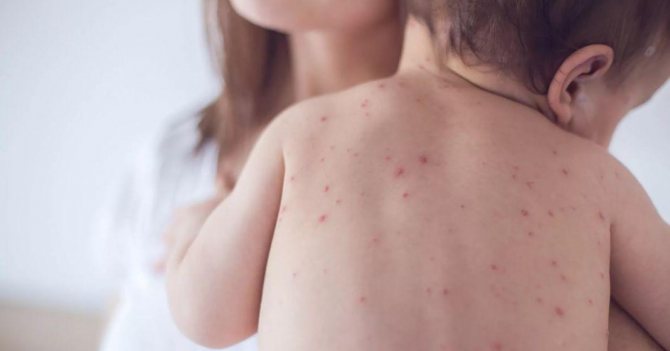
Illustrative photo
Ukrainian pediatrician Evgeniy Komarovsky spoke about the most effective and most terrible ways to fight measles. The video was published on the doctor’s YouTube channel, Tengrinews.kz reports.
201 confirmed cases of measles have been recorded in Astana. Another 22 cases were identified in Almaty. For Kazakhstan, this is the second increase in incidence in the last ten years.
“Measles is a flying infection, which means that if a person is 100 meters away from you, you can become infected with air currents. When a person with the flu enters a classroom, he can infect everyone in the class, but cannot infect another class. A child who came to school with measles infected the entire school. If there is a child with measles in the entrance on the first floor, then on the ninth floor there are contacts with measles,” said the pediatrician.
According to Komarovsky, previously, out of 100 children, one, sometimes more, died from measles. With the advent of antibiotics, mortality decreased by 10 times. One child in a thousand began to die.
“It’s not because antibiotics treat measles, measles is a viral infection. But with measles, bacterial complications arise that can kill a person,” the doctor said.
The most effective weapon against measles is vaccination.
“Society may not vaccinate children at all. We will simply pay the price - every child will get sick, one in a thousand will die, two or three will have serious complications. There is a price that society can pay. Or society can vaccinate. Then the situation changes fundamentally, and measles simply disappears from the face of the Earth, from the face of the country where this vaccination takes place,” said Komarovsky.
Patients with measles, he said, can die from pneumonia, meningoencephalitis, and can also go blind.
“The worst and craziest situation occurs when half are vaccinated and half are not vaccinated. This leads to adults starting to get sick. When no one is vaccinated, they are exposed to the virus in childhood. When half are vaccinated, the chances of encountering the virus in childhood decrease, and adults begin to encounter the virus. And adults get sick much more seriously than children. And then the cost of the disease increases many times over. And adults begin to die,” the pediatrician explained.
According to him, ideally, society should be 90-95 percent vaccinated against measles in order to completely forget about this disease, since the virus will have nowhere to circulate.
“Vaccination has become so effective that people have forgotten what measles is. People are no longer afraid of measles, but they are afraid of vaccinations. The effectiveness of vaccination works against vaccination itself,” Komarovsky noted.
He clarified that people should be vaccinated twice - a year and at six years.
“During outbreaks, according to WHO standards, you can vaccinate not from a year, but from 9 months. If you doubt whether you are vaccinated or not, nothing bad will happen to you even with the third vaccination,” the doctor added.
Preventive measures
Prevention of measles in children includes several important points.
- Vaccination. The most effective protection is a vaccine. It can be single-component or multi-component (MMR, or measles, mumps, rubella). The vaccination is carried out at 1 year, then again at 6 years. Up to 10% of vaccinated children may develop a mild form of infection with a minor rash and fever. At this point, children are considered not contagious. Due to the massive refusal of vaccinations in Russia, cases of measles have become more frequent. According to statistics, 80% of children who suffered from this disease were not vaccinated.
- Taking immunoglobulin, or passive immunization. If it is known that the child had contact with a carrier of measles or was in an outbreak of the disease, immunoglobulin can be used, which provides immunity from infection for one month.
- Quarantine. In the children's group where a case of measles was recorded, anti-epidemic measures and daily preventive examination of children are carried out. A child is considered contagious several days before the first symptoms appear, as well as for 5 days after the first skin rash appears. Staying in a children's group is prohibited. Quarantine is carried out only for unvaccinated children under 17 years of age.
Recurrence of measles occurs in extremely rare cases. After an illness, immunity is lifelong. After vaccination, stable immunity remains for 15 years.
A sick person is always the source of infection. It is often dangerous for surrounding people already from the 7th day of infection and especially when a rash appears. The measles virus stops entering the environment on the 4th day from the moment the elements appear on the skin and from that day on the person becomes non-infectious.
Measles depletes the immune system and for several months after the illness the defense against infections is weakened. During this period, the child often gets sick. Therefore, try not to visit large crowds of people with your baby. Feed him protein and vitamin foods, walk more in the fresh air.
Causes
The cause of the spread of infection is always the sick person. The virus enters the air through droplets of saliva released when coughing, sneezing or talking, and then “moves” into the respiratory tract of a nearby child. The patient is considered contagious during the last two days of the incubation period of the virus and up to the 4th day of the rash.
Measles most often affects children under 5 years of age. Adults who have not undergone mandatory vaccination get sick less often, but their risk of infection is very high, and the disease is more severe than in children. In the spring-winter period, there is a peak incidence, and a decline occurs in August and September. After recovery, persistent lifelong immunity is maintained with the preservation of anti-measles antibodies in the blood.
Infants under 1 year of age practically cannot get measles, since antibodies received from their mother are retained in their blood, but gradually by the age of one year their number decreases, accordingly increasing the risk of developing the disease without vaccination. When a pregnant woman is infected, the virus can be transmitted through the placenta to the fetus and the development of congenital measles.
Incubation period
This is the time period that begins at the moment of infection and continues until the first signs of the disease appear. It is generally accepted that this period in children is 7-14 days. At this stage, the virus multiplies “quietly” in the body, there are no symptoms of measles, and the child is not bothered by anything at all. In this case, the baby becomes infectious to others only in the last 5 days of the incubation period.
How measles manifests itself: photos of children with a rash
Measles can be distinguished from other diseases by the nature of its course. First, a temperature of up to 39 degrees appears, then the eyes turn red, begin to water and fester.
Pay attention to the photo - a symptom of measles in children at the initial stage is also Velsky-Filatov spots on the mucous membrane of the cheeks:
Symptoms of measles in children
Oddly enough, even the most perceptive parent will not see how measles begins. This insidious disease develops in stages, and the initial period can last weeks and not manifest itself at all. The child will continue to have fun and play, and at the same time the harmful virus will undermine his body from the inside.
The first signs of measles are very similar to the symptoms of ARVI. The child appears:
- cough,
- runny nose,
- the temperature rises.
This period is considered the first and is called incubation.
The most characteristic sign of measles is spots at the base of the molars. They occur because the virus destroys the mucous membrane. She is getting thinner. White spots are surrounded by a red, swollen border. By this sign, measles can be distinguished from other diseases that have similar manifestations.
The progression of measles in a child is a sequential change of 3 stages:
- catarrhal period;
- rash stage;
- period of convalescence.
Each of them has its own time range and corresponding symptoms.
In the table we will look at how measles manifests itself at different stages
| Description of symptoms | |
| Catarrhal period | Lasts in children from 3 to 5 days. At this time, a number of symptoms similar to the common cold appear, which are caused by the circulation of the virus in the blood (viremia):
During this period, children's activity decreases. They become lethargic, moody and inactive due to weakness. Sleep is disturbed and appetite worsens. |
| Rashes | The measles rash appears 3-4 days after the onset of the disease. The period of rash lasts 4-5 days.
|
| Pigmentation | Approximately from the fourth day of the rash period, the baby’s condition begins to improve. The baby is no longer contagious. The pigmentation stage can last 7-10 days. The spots gradually lighten and disappear:
The rash does not leave marks or scars on the skin. |
Any of these symptoms should be a reason to consult a doctor. If necessary, the pediatrician will refer the little patient to specialized specialists for additional examination.
Complications
Various consequences arise due to weakened immunity, due to which a viral infection is complicated by the addition of a bacterial one. In patients with measles, secondary bacterial pneumonia is often diagnosed. Stomatitis is rare, but possible.
Most often this is:
- otitis;
- laryngitis;
- bronchopneumonia;
- stomatitis;
- glossitis;
- blindness;
- encephalitis;
- inflammation of the lymph nodes in the neck;
- tracheobronchitis;
- polyneuritis;
- damage to the central nervous system.
Complications that occur in young children can hardly be called a rare occurrence. That is why the baby needs to be treated under the strict supervision of a local pediatrician. Ideally, the doctor will visit your child at least once every three days.
Diagnostics
To make a reliable diagnosis, your child must be sent for the following types of laboratory tests:
- general blood and urine tests;
- serological test (detection of antibodies to the measles virus in the child’s blood serum);
- isolation of the virus from the blood;
- chest x-ray (done only in exceptional cases);
- electroencephalography (performed only in the presence of complications on the nervous system).
Despite the severity of the disease, the prognosis for childhood measles is favorable.
Most complications require immediate hospitalization of the child.
Treatment of measles
Antibacterial therapy for measles in children is not prescribed because the disease is viral and not bacterial in nature.
Prevention
The main role in the prevention of measles in children belongs to active immunization. Vaccination is based on the process of artificially creating an immune response to infections by introducing into the body the protein components of bacteria and viruses that cause the development of infectious processes.
When the first signs of the disease appear, parents are obliged to isolate the child from other children and call a local pediatrician at home; if the child attended a child care institution (kindergarten, school), the mother must inform this institution about the child’s illness.
General recommendations for measles prevention:
- isolation of children with measles from the group;
- compliance with quarantine measures in groups for 21 days;
- regular ventilation and wet cleaning of premises, especially if there was a sick child there;
- timely administration of immunoglobulin to contact children no later than 3-5 days from the moment of contact;
- routine vaccination and revaccination of children according to the vaccination calendar.
Recurrence of measles occurs in extremely rare cases. After an illness, immunity is lifelong. After vaccination, stable immunity remains for 15 years. If you notice the appearance of a rash in a child, you should consult a doctor, he will help you with his explanations. It is important to remember that it is not the virus itself that is dangerous, but the negative consequences in the form of complications that it often has.
Material used from the site: Measles in children: photos, signs, symptoms and treatment... simptomy-i-lechenie.net
Prepared by: local pediatrician O.V. Polezhaeva.



